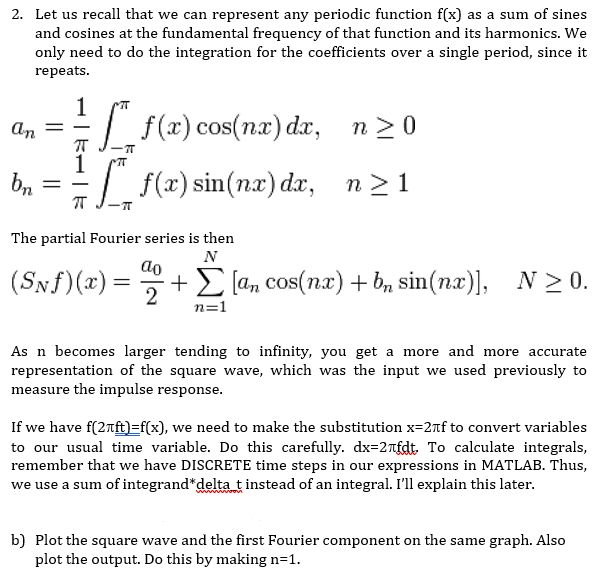
2. Let us recall that we can represent any periodic function f(x) as a sum of sines and cosines at the fundamental frequency of that function and its harmonics. We only need to do the integration for the coefficients over a single period, since it repeats. 1 an = T L 5(2) cos(na)da, n20 L S(x) sin(nx)dx, n21 bn TT The partial Fourier series is then N ao (SNf)(x) = + [an cos(nx) + bn sin(nx)], N>0. 2 n=1 As n becomes larger tending to infinity, you get a more and more accurate representation of the square wave, which was the input we used previously to measure the impulse response. If we have f(2aft)=f(x), we need to make the substitution x=2af to convert variables to our usual time variable. Do this carefully. dx=2afdt. To calculate integrals, remember that we have DISCRETE time steps in our expressions in MATLAB. Thus, we use a sum of integrand* delta t instead of an integral. I'll explain this later. b) Plot the square wave and the first Fourier component on the same graph. Also plot the output. Do this by making n=1. 2. Let us recall that we can represent any periodic function f(x) as a sum of sines and cosines at the fundamental frequency of that function and its harmonics. We only need to do the integration for the coefficients over a single period, since it repeats. 1 an = T L 5(2) cos(na)da, n20 L S(x) sin(nx)dx, n21 bn TT The partial Fourier series is then N ao (SNf)(x) = + [an cos(nx) + bn sin(nx)], N>0. 2 n=1 As n becomes larger tending to infinity, you get a more and more accurate representation of the square wave, which was the input we used previously to measure the impulse response. If we have f(2aft)=f(x), we need to make the substitution x=2af to convert variables to our usual time variable. Do this carefully. dx=2afdt. To calculate integrals, remember that we have DISCRETE time steps in our expressions in MATLAB. Thus, we use a sum of integrand* delta t instead of an integral. I'll explain this later. b) Plot the square wave and the first Fourier component on the same graph. Also plot the output. Do this by making n=1







